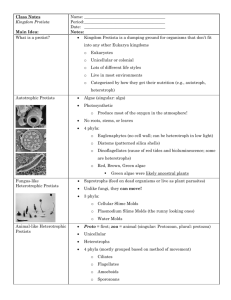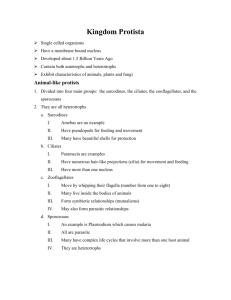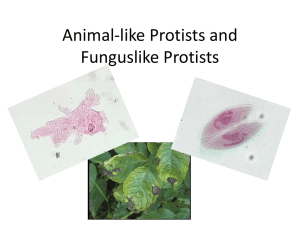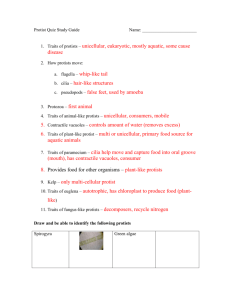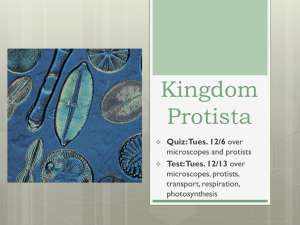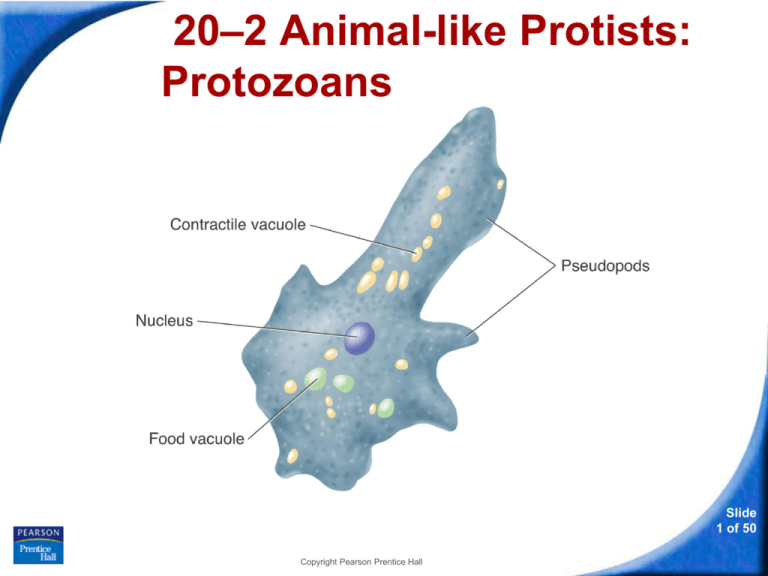
20–2 Animal-like Protists:
Protozoans
Slide
1 of 50
Copyright Pearson Prentice Hall
20–2 Animal-like Protists:
Protozoans
20-2 Animal-like Protists:
There are four phyla of animal-like protists:
• zooflagellates
• sarcodines
• ciliates
• sporozoans
Animal-like protists are classified by their means of
movement.
Slide
2 of 50
Copyright Pearson Prentice Hall
20–2 Animal-like Protists:
Protozoans
Zooflagellates
Zooflagellates
What are the distinguishing features of the
zooflagellates?
Slide
3 of 50
Copyright Pearson Prentice Hall
20–2 Animal-like Protists:
Protozoans
Zooflagellates
Animal-like protists that swim using flagella
are called zooflagellates.
Slide
4 of 50
Copyright Pearson Prentice Hall
20–2 Animal-like Protists:
Protozoans
Zooflagellates
Flagella are long, whiplike projections that allow a cell
to move.
Most zooflagellates have one or two flagella,
although a few species have many.
Slide
5 of 50
Copyright Pearson Prentice Hall
20–2 Animal-like Protists:
Protozoans
Zooflagellates
Giardia
Giardia lives inside the intestines of
infected humans or animals. Individuals
become infected through ingesting or
coming into contact with contaminated
food, soil, or water.
Copyright Pearson Prentice Hall
Slide
6 of 50
20–2 Animal-like Protists:
Protozoans
Sarcodines
Sarcodines
What are the distinguishing features of the
sarcodines?
Slide
7 of 50
Copyright Pearson Prentice Hall
20–2 Animal-like Protists:
Protozoans
Sarcodines
Sarcodines are animal-like protists that
have pseudopods.
Pseudopods are temporary cytoplasmic
projections used for feeding or movement.
Slide
8 of 50
Copyright Pearson Prentice Hall
20–2 Animal-like Protists:
Protozoans
Sarcodines
Amoebas
Amoebas are flexible, active cells with thick
pseudopods that extend out of the central mass of
the cell.
Cytoplasm streams into the pseudopod, and the rest
of the cell follows.
This type of locomotion is known as amoeboid
movement.
Slide
9 of 50
Copyright Pearson Prentice Hall
20–2 Animal-like Protists:
Protozoans
Sarcodines
Structures of an Amoeba
Contractile vacuole
Pseudopods
Nucleus
Food vacuole
Slide
10 of 50
Copyright Pearson Prentice Hall
20–2 Animal-like Protists:
Protozoans
Sarcodines
Amoebas surround food and engulf it in a food
vacuole.
A food vacuole is a small cavity in the cytoplasm
that temporarily stores food.
Food is digested and nutrients are passed to the cell.
Waste stays in the vacuole until it is released outside
the cell.
Slide
11 of 50
Copyright Pearson Prentice Hall
20–2 Animal-like Protists:
Protozoans
Sarcodines
Other sarcodines include:
• Foraminiferans
• Heliozoans (“sun animals”)
Slide
12 of 50
Copyright Pearson Prentice Hall
20–2 Animal-like Protists:
Protozoans
Ciliates
Ciliates
What are the distinguishing features
of the ciliates?
Slide
13 of 50
Copyright Pearson Prentice Hall
20–2 Animal-like Protists:
Protozoans
Ciliates
Ciliates use cilia for feeding and
movement.
Cilia are short hairlike projections that
propel a cell.
Slide
14 of 50
Copyright Pearson Prentice Hall
20–2 Animal-like Protists:
Protozoans
Ciliates
Paramecia
One type of ciliate is a paramecium.
In a paramecium, the cilia are grouped into rows
and bundles, and beat in a regular pattern.
Slide
15 of 50
Copyright Pearson Prentice Hall
20–2 Animal-like Protists:
Protozoans
Slide
16 of 50
Copyright Pearson Prentice Hall
20–2 Animal-like Protists:
Protozoans
Ciliates
Structures of a Paramecium
Slide
17 of 50
Copyright Pearson Prentice Hall
20–2 Animal-like Protists:
Protozoans
Ciliates
Conjugation
Ciliates reproduce asexually by mitosis and
cytokinesis.
When placed under stress, paramecia may engage
in conjugation, which allows them to exchange
genetic material with other individuals.
Slide
18 of 50
Copyright Pearson Prentice Hall
20–2 Animal-like Protists:
Protozoans
Ciliates
Conjugation is not a form of reproduction. In large
populations, conjugation helps produce and maintain
genetic diversity.
http://www.youtube.
com/watch?v=5c_Vh
b0vBVw
Slide
19 of 50
Copyright Pearson Prentice Hall
20–2 Animal-like Protists:
Protozoans
Sporozoans
Sporozoans
What are the distinguishing features of the
sporozoans?
Plasmodium
Slide
20 of 50
Copyright Pearson Prentice Hall
20–2 Animal-like Protists:
Protozoans
Sporozoans
Sporozoans do not move on their own—
they are parasitic.
Sporozoans are parasites of a wide variety of
organisms, including worms, fish, birds, and
humans.
Slide
21 of 50
Copyright Pearson Prentice Hall
20–2 Animal-like Protists:
Protozoans
Sporozoans
Many sporozoans have complex life cycles that
involve more than one host.
Sporozoans reproduce by sporozoites.
A sporozoite can attach itself to a host cell, penetrate
it, and then live within it as a parasite.
Slide
22 of 50
Copyright Pearson Prentice Hall
20–2 Animal-like Protists:
Protozoans
Animal-like Protists and Disease
Animal-like Protists and Disease
How do animal-like protists harm other
living things?
Slide
23 of 50
Copyright Pearson Prentice Hall
20–2 Animal-like Protists:
Protozoans
Animal-like Protists and Disease
Some animal-like protists cause serious
diseases, including malaria and African
sleeping sickness.
Slide
24 of 50
Copyright Pearson Prentice Hall
20–2 Animal-like Protists:
Protozoans
Animal-like Protists and Disease
Malaria
Malaria is one of the world’s most serious
infectious diseases, killing as many as 2 million
people each year.
The sporozoan Plasmodium, which causes
malaria, is carried by the female Anopheles
mosquito.
Slide
25 of 50
Copyright Pearson Prentice Hall
20–2 Animal-like Protists:
Protozoans
Slide
26 of 50
Copyright Pearson Prentice Hall
20–2 Animal-like Protists:
Protozoans
Animal-like Protists and Disease
Malarial Infection
Slide
27 of 50
Copyright Pearson Prentice Hall
20–2
Click to Launch:
Continue to:
- or -
Slide
28 of 50
Copyright Pearson Prentice Hall
20–2
Structures found in sarcodines that are used for
feeding and movement are known as
a. pseudopods.
b. flagella.
c. cilia.
d. food vacuoles.
Slide
29 of 50
Copyright Pearson Prentice Hall
20–2
The structure found in most ciliates that contains
a “reserve copy” of all the cell's genes is the
a. macronucleus.
b. micronucleus.
c. trichocysts.
d. contractile vacuole.
Slide
30 of 50
Copyright Pearson Prentice Hall
20–2
One way to classify the various groups of
animal-like protists is by
a. the presence of a nuclear membrane.
b. the presence of mitochondria.
c. their means of movement.
d. the number of contractile vacuoles.
Slide
31 of 50
Copyright Pearson Prentice Hall
20–2
Malaria is caused by the sporozoan
a. Plasmodium.
b. Anopheles.
c. Amoeba.
d. Paramecium.
Slide
32 of 50
Copyright Pearson Prentice Hall
END OF SECTION



